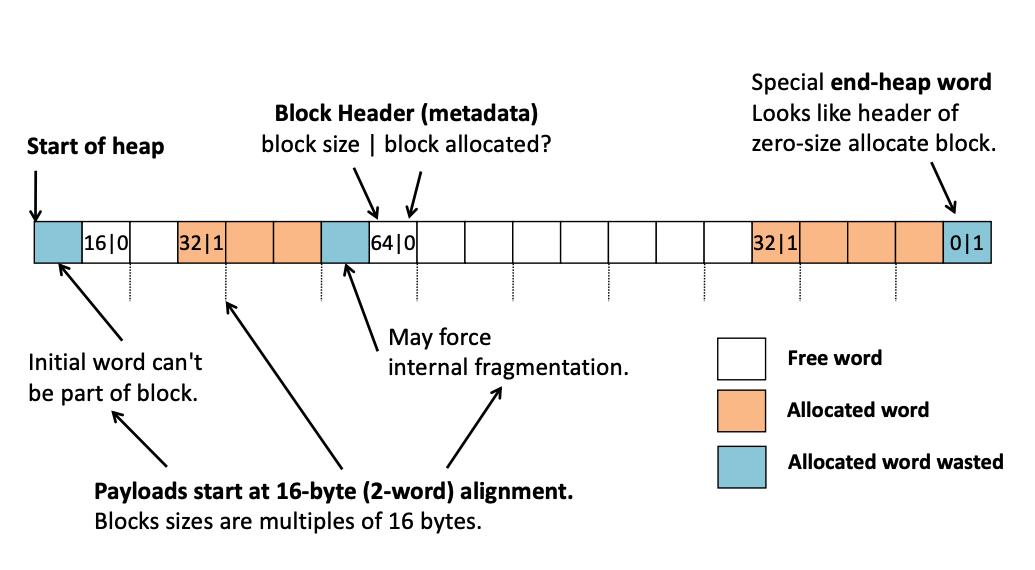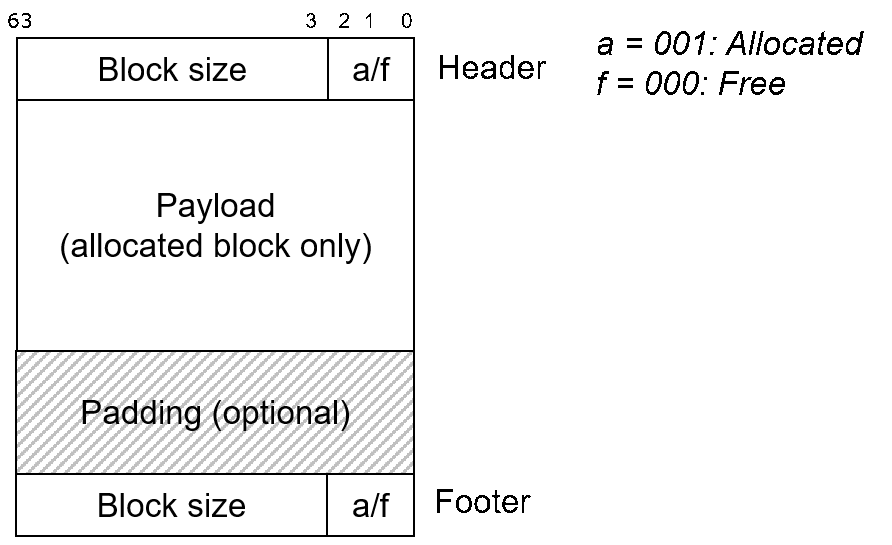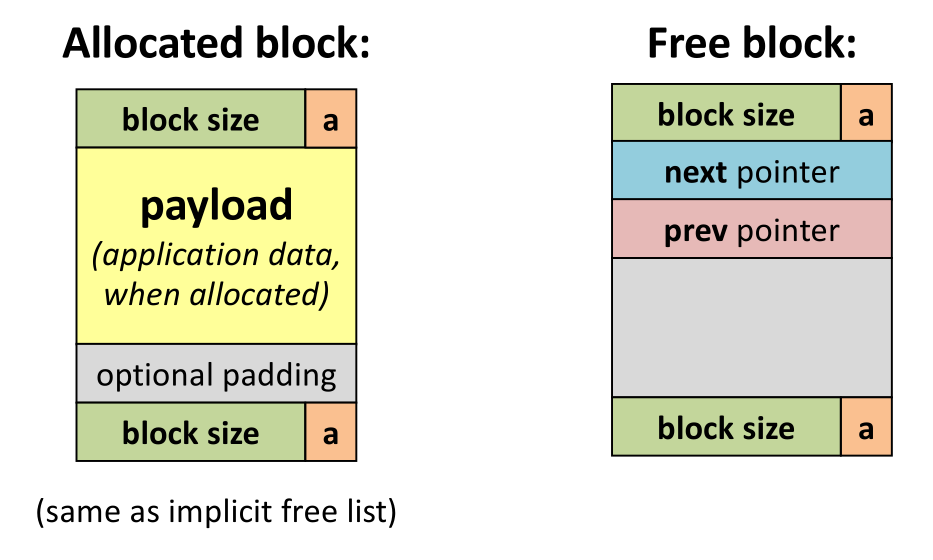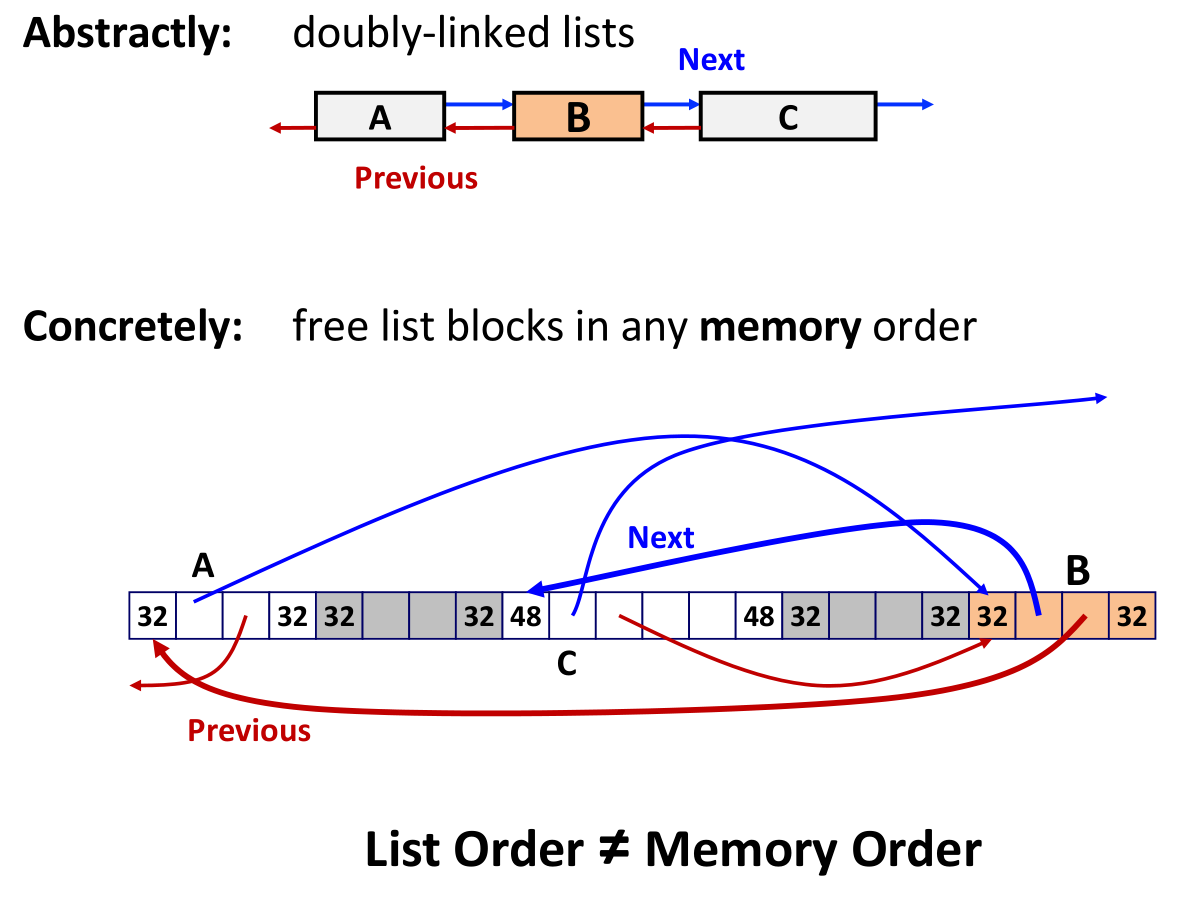CS 208 s21 — Dynamic Memory Allocation: Free Lists
Table of Contents
1 Video
Here is a video lecture for the material outlined below. It covers CSPP section 9.9.6 through 9.9.14 (p. 847–865). It contains sections on
- introduction (0:01)
- implicit free list concept (2:07)
- minimum block size (11:50)
- epilogue block (13:18)
- basic spreadsheet example (14:27)
- placement policy (18:37)
- splitting (23:20)
- false fragmentation (25:08)
- coalescing (26:43)
- boundary tags (31:05)
- coalescing: four cases (32:51)
- when the heap runs out of space (37:35)
- explicit free list (39:34)
The Panopto viewer has table of contents entries for these sections. Link to the Panopto viewer: https://carleton.hosted.panopto.com/Panopto/Pages/Viewer.aspx?id=4597ad39-7990-43f1-a0bc-ac59010dee45
2 Introduction
Implementation questions:
- freeing: how much do we free given just a pointer?
- free block organization: how to keep track of them
- placement: which free block should we choose to fulfill a request
- splitting: what do we do with the remainder of a free block after part of it is allocated
- coalescing: what do we do when a block is freed
3 Implicit Free List


- since block size will always be a multiple of 16 due to alignment, the four lower order bits of the size will always be 0
- we can make efficient use of the header by using these four bits to indicate if the block is allocated or free
- the block size includes the payload and any padding, and is thus an implicit pointer to the start of the next block
- we will need some special block to mark the end of the free list (e.g, allocated bit, size 0)
- implicit free list is simple, but operations are linear in the number of blocks since we have to traverse the list
- alignment combined with block format impose a minimum block size
- https://docs.google.com/spreadsheets/d/1Tj8LTKBBqLodX5K8GbqCVUSWOFur6KzXZshQhx0bF4E/edit?usp=sharing
3.1 Placing Allocated Blocks
- an allocator's placement policy determines the choice of free block to fulfill allocation
- first fit: take the first free block that's big enough
- end up with lots of small "splinters" near the start of the list, large blocks near the end
- next fit: like first fit, but start search where the previous one left off
- unclear if this is better than first fit in practice
- best fit: choose the smallest free block that fits
- better memory utilization, but requires exhaustive search
- first fit: take the first free block that's big enough
- if the fit is not good, an allocator might opt to split the free block into two parts
- if necessary, an allocate will ask the kernel for additional heap memory, inserting a new free block into the list
3.2 Coalescing Free Blocks
- adjacent free blocks cause false fragmentation—free memory chopped up into many small unusable free blocks
- to address this an allocator must merge (coalesce) adjacent free blocks
- immediate coalescing: merge blocks whenever one is freed
- simple, constant time
- can lead to a form of thrashing where a block is coaslesced and split repeatedly
- deferred coalescing: wait and coaslesce at a later time (e.g., scan the hope when a request fails)
- often the more efficient choice
- immediate coalescing: merge blocks whenever one is freed
3.2.1 Boundary Tags
- with a simple header containing the block size, we can reach the next block, but what about the previous block?
- we'd have to traverse the free list until we reached the current block
- instead, add a footer to each block that's the same as the header
- together, the header and footer form boundary tags
- if we go back one word from the header, we get to the footer of the previous block

- four cases for coalescing:
- previous and next blocks are both allocated
- previous block is allocated, next block is free
- previous block is free, next block is allocated
- previous and next blocks are both free
- https://docs.google.com/spreadsheets/d/1Tj8LTKBBqLodX5K8GbqCVUSWOFur6KzXZshQhx0bF4E/edit?usp=sharing
- boundary tags can introduce significant memory overhead in the case of many small blocks
- fortunately, we only need to have footers in free blocks, since we only care about the size of the previous block when it is free and we want to merge it
- we still need a way to tell if the previous block is allocated, so we'll add that information to one of the unused low-order bits of the header
4 Explicit Free Lists


- organize free list as a doubly-linked list using the payload of free blocks (by definition unused) to store the pointers
- now placement is linear in the number of free blocks instead of the total number of blocks
- assuming a first-fit policy:
- if list uses last-in first-out by inserting new free blocks at the head, freeing a block is constant time
- better memory utilization can be achieved if free blocks are maintained in address order
- minimum block size must increase to accomodate list pointers, potentially increasing internal fragmentation
- splitting, boundary tags, coalescing are general to all allocators
- free blocks still coalesce with those adjacent in memory
- remove from list, reinsert at the head
- list can hold blocks in any order, regardless of memory address
- free blocks still coalesce with those adjacent in memory